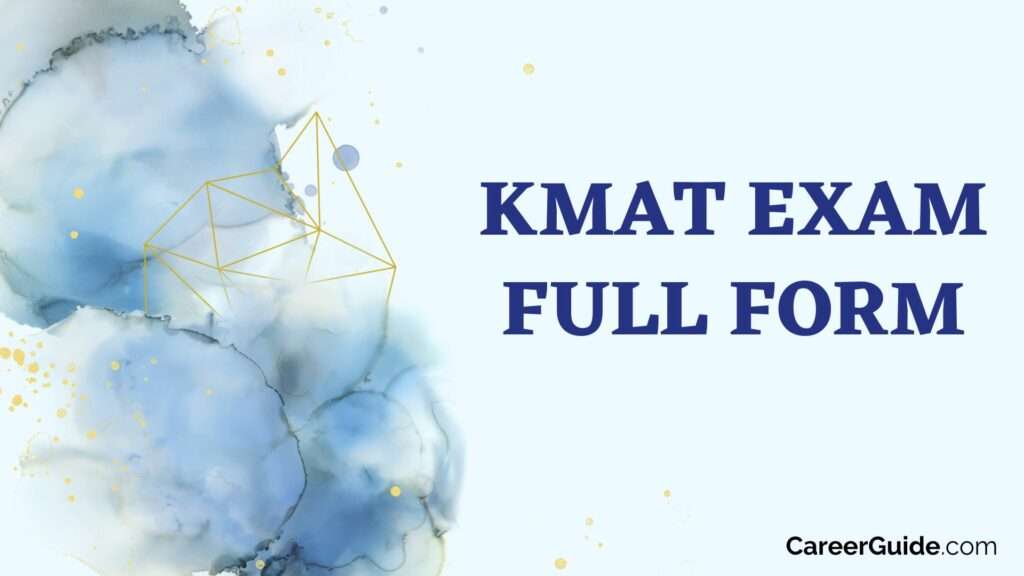Full Form of KMAT Exam: The Karnataka Management Aptitude Test (KMAT) is a management entrance exam at the state level administered by the Karnataka Private Post Graduate Colleges Association (KPPGCA). KMAT serves as an entrance point for individuals seeking admission to MBA, PGDM, and MCA programs provided by different B-schools and universities within the state of Karnataka.
Securing success in the KMAT requires a deep understanding of the examination syllabus. This all-encompassing guide extensively explores the KMAT syllabus, delivering intricate insights into every section. It not only highlights crucial topics but also furnishes effective strategies for meticulous preparation.
The KMAT syllabus, a roadmap to triumph, is dissected in this guide to empower aspirants with the knowledge necessary to navigate through the diverse sections of the exam. By breaking down the syllabus into its constituent elements, the guide illuminates key areas that candidates must focus on to excel in the KMAT.
Moreover, the guide goes beyond a mere enumeration of topics; it provides a nuanced understanding of each section, elucidating the intricacies that may be encountered during the examination. By doing so, it equips candidates with the tools to approach the KMAT with confidence and competence.
To optimize preparation, the guide incorporates proven strategies tailored to each section, ensuring aspirants not only cover the syllabus comprehensively but also develop the skills essential for success. With detailed insights and strategic guidance, this comprehensive KMAT preparation guide is an indispensable companion for those aspiring to conquer the examination and embark on a path to academic triumph.

Full Form of KMAT
Securing success in the KMAT requires a deep understanding of the examination syllabus. This all-encompassing guide extensively explores the KMAT syllabus, delivering intricate insights into every section. It not only highlights crucial topics but also furnishes effective strategies for meticulous preparation.
The KMAT syllabus, a roadmap to triumph, is dissected in this guide to empower aspirants with the knowledge necessary to navigate through the diverse sections of the exam. By breaking down the syllabus into its constituent elements, the guide illuminates key areas that candidates must focus on to excel in the KMAT.
Moreover, the guide goes beyond a mere enumeration of topics; it provides a nuanced understanding of each section, elucidating the intricacies that may be encountered during the examination. By doing so, it equips candidates with the tools to approach the KMAT with confidence and competence.
To optimize preparation, the guide incorporates proven strategies tailored to each section, ensuring aspirants not only cover the syllabus comprehensively but also develop the skills essential for success. With detailed insights and strategic guidance, this comprehensive KMAT preparation guide is an indispensable companion for those aspiring to conquer the examination and embark on a path to academic triumph.
History of KMAT
Inaugurated in the year 2003, the Karnataka Management Aptitude Test (KMAT) made its debut under the auspices of the Karnataka Private Post Graduate Colleges’ Association (KPPGCA). The fundamental aim behind the exam’s establishment was to streamline the admission process for postgraduate management programs, encompassing disciplines such as MBA, PGDM, and MCA, across various reputable B-schools and universities in the state of Karnataka.
Since its inception, KMAT has steadily ascended the echelons of credibility and recognition as a standardized entrance test for prospective management students in Karnataka. Over the years, it has garnered a reputation for being a trustworthy and pivotal assessment, playing a crucial role in determining the eligibility of candidates for coveted positions in esteemed educational institutions.
The evolution of KMAT into one of the most sought-after examinations for management aspirants in Karnataka underscores its significance in the academic landscape. As a consistent and reliable barometer of aptitude and competence, KMAT continues to serve as a beacon for individuals aspiring to pursue postgraduate management studies, contributing to the development of skilled and adept professionals in the dynamic field of business and administration.
KMAT Eligibility Criteria
To qualify for the Karnataka Management Aptitude Test (KMAT), candidates are required to adhere to specific eligibility criteria established by the conducting authority. It is crucial to note that these criteria might undergo slight variations annually, and candidates are strongly encouraged to consult the official website for the most current information. As of my last update in September 2021, the general eligibility criteria for KMAT encompass the following:
**Nationality:** Applicants must hold Indian citizenship.
**Academic Qualification:**
– *For MBA/PGDM:* Candidates should possess a bachelor’s degree from a recognized university, securing a minimum of 50% aggregate marks (45% for SC/ST candidates).
– *For MCA:* Aspiring candidates must have a bachelor’s degree from a recognized university with a minimum of 50% aggregate marks (45% for SC/ST candidates). Additionally, proficiency in Mathematics at either the 10+2 level or graduation level is a prerequisite.
**Appearing Candidates:** Individuals who are in the final year of their bachelor’s degree program are eligible to apply for KMAT.
It is imperative for candidates to stay abreast of any modifications in the eligibility criteria by regularly checking the official website. Adhering to these guidelines ensures that aspiring candidates meet the necessary prerequisites for participating in the KMAT, facilitating a seamless and fair assessment process for admission to coveted management programs.
KMAT Application Process
The application process for the Karnataka Management Aptitude Test (KMAT) encompasses several sequential stages, ensuring a systematic and streamlined approach for candidates. Below is a comprehensive step-by-step guide to navigating the KMAT application process:
1. Registration:
- Initiate the process by visiting the official KMAT website.
- Complete the registration by furnishing essential details such as name, email ID, and mobile number.
- Upon successful registration, candidates are furnished with unique login credentials for future access.
2. Login:
- Utilize the provided login credentials to access the KMAT application form.
3. Fill in the Application Form:
- Thoroughly complete the application form, ensuring accuracy in the provision of personal details, academic qualifications, and contact information.
4. Upload Documents:
- Candidates are mandated to upload scanned copies of their recent photograph and signature, adhering to the specified format and size requirements.
5. Application Fee Payment:
- Fulfill the application fee payment using the available online payment options, which typically include credit/debit cards, net banking, or UPI.
6. Print Application:
- Following successful payment, candidates should generate a printout of the completed application form for future reference.
7. Admit Card Download:
- Once the application process concludes, candidates can download their admit cards from the official website within the timeframe stipulated by the conducting authority.
This step-by-step guide ensures a seamless application process for prospective KMAT candidates, facilitating their entry into the evaluation phase for admission to management programs in Karnataka. It is imperative for applicants to meticulously follow each step and adhere to deadlines, guaranteeing a hassle-free application experience.
KMAT Exam Pattern
Understanding the exam pattern is crucial for candidates preparing for the KMAT exam. It helps them familiarize themselves with the structure of the test and prepare accordingly. Here’s an overview of the KMAT exam pattern:
Mode of Examination:
- KMAT is administered as a paper-based test, where candidates utilize Optical Mark Recognition (OMR) sheets to mark their responses.
Sections:
- Depending on the course applied for, the KMAT exam is structured into three sections:
- For MBA/PGDM: Verbal Ability and Reading Comprehension, Quantitative Ability, Logical Reasoning.
- For MCA: Verbal Ability and Reading Comprehension, Quantitative Ability, Logical Reasoning, and General Knowledge.
Total Questions:
- While the total number of questions may vary annually, it typically hovers around 120 questions for MBA/PGDM and 120 questions for MCA.
Type of Questions:
- KMAT features multiple-choice questions (MCQs), presenting candidates with four options for each question.
Duration:
- Candidates are allocated a standard duration of 120 minutes (2 hours) to complete the examination. Efficient time management is crucial to addressing the diverse sections within the stipulated timeframe.
Marking Scheme:
- Each correct response is awarded one mark, fostering a positive marking system. Importantly, there is no provision for negative marking, encouraging candidates to attempt all questions without the fear of penalization for incorrect answers.
This comprehensive understanding of the KMAT exam pattern empowers candidates to navigate the test confidently, strategizing their approach to each section effectively. It serves as a valuable guide for those preparing to embark on this assessment journey, aiding them in optimizing their performance on exam day.
KMAT Syllabus
To excel in the KMAT exam, candidates must possess a comprehensive understanding of the syllabus, enabling them to focus their preparation effectively. Below is an in-depth breakdown of the syllabus for each section of the KMAT exam:
Verbal Ability and Reading Comprehension:
- Comprehension of passages.
- Verbal reasoning.
- Syllogisms.
- Antonyms and synonyms.
- Fill in the blanks.
- Jumbled sentences.
- Analogies.
- Sentence correction.
- Idioms and phrases.
Quantitative Ability:
- Arithmetic problems.
- Geometry.
- Trigonometry.
- Ratios and proportions.
- Percentages.
- In-equations.
- Quadratic and linear equations.
- Algebra.
- Time, speed, and distance.
- Work and time.
- Number system.
- Modern math.
Logical Reasoning:
- Coding-decoding.
- Symbol-based problems.
- Puzzles.
- Data sufficiency.
- Logical reasoning.
- Blood relations.
- Graphs and charts.
- Critical reasoning.
General Knowledge (Applicable to MCA):
- Current affairs.
- General knowledge.
- Business.
- Punch line of companies.
- Top officials of big companies.
- Major corporate events.
- Famous award and prizes.
- Science.
- History.
- Geography.
- International organizations.
Significance of KMAT:
1. Standardized Evaluation:
- KMAT provides a standardized platform for evaluating the aptitude and skills of management aspirants, ensuring a fair and consistent admission process.
2. Wider Acceptance:
- Scores obtained in KMAT are accepted by numerous B-schools, MBA colleges, and universities across Karnataka, broadening the scope of opportunities for candidates.
3. Diverse Course Options:
- KMAT covers a range of management courses, including MBA, PGDM, and MCA, allowing candidates to pursue programs that align with their career goals and interests.
4. Merit-Based Admissions:
- Admissions to management courses in Karnataka are often merit-based, and KMAT scores play a crucial role in determining merit, ensuring that deserving candidates are granted admission.
5. Cost-Effective:
- KMAT is known for its reasonable application fees, making it an affordable option for students from diverse backgrounds.
6. Opportunity for All:
- The inclusion of both Karnataka and non-Karnataka candidates ensures that individuals from various regions have a chance to pursue management education in the state.
7. Fair and Transparent Process:
- The exam follows a fair and transparent evaluation process, essential for maintaining the credibility of the admission process.
KMAT Reservation Policy
The KMAT exam adheres to a reservation policy to promote diversity and equal opportunities for candidates belonging to various categories. The reservation percentages are as follows:
- Scheduled Castes (SC): 15%
- Scheduled Tribes (ST): 7.5%
- Other Backward Classes (OBC): 27%
To avail of the benefits under the reservation policy, candidates are required to submit the necessary documents, such as caste certificates, during the admission process. It’s important to note that the reservation policy might exhibit slight variations from one B-school to another. Thus, it is advisable for candidates to thoroughly review the specific reservation policies of the B-schools they are interested in before applying for the KMAT exam.
Here are some additional key points regarding the KMAT reservation policy:
- Universal Applicability:
- The reservation policy is applicable to all seats in participating KMAT B-schools, ensuring a consistent approach to admissions.
- Inclusivity Across Institutions:
- Both government and private B-schools adhere to the reservation policy, emphasizing equal opportunities in educational institutions.
- Applicability to All Categories:
- The reservation policy encompasses all categories of candidates, including general category candidates, reserved category candidates, and even foreign nationals seeking admission through KMAT.
Candidates seeking clarification or additional information about the KMAT reservation policy can contact the KSPITTC office. Ensuring a clear understanding of the reservation policy is crucial for candidates to navigate the admission process smoothly and make informed decisions about their applications.
Other Requirements
Absolutely, it’s crucial for candidates to recognize that while the general eligibility criteria provide a foundation for KMAT, individual participating institutions may impose additional admission requirements. These supplementary requirements can vary among institutions and may encompass factors such as work experience, entrance test scores beyond KMAT, and performance in group discussions and personal interviews.
Here’s a breakdown of potential additional admission requirements:
- Work Experience:
- Some institutions may consider work experience as a factor in the admission process. Candidates with relevant professional experience may receive favorable consideration during the selection process.
- Other Entrance Test Scores:
- In addition to KMAT scores, certain institutions might consider scores from other entrance exams as part of their admission criteria. Candidates should be aware of any specific tests designated by the institutions of their interest.
- Group Discussion (GD) and Personal Interview (PI):
- Institutions may conduct group discussions and personal interviews to assess candidates’ communication skills, problem-solving abilities, and overall suitability for the program. Performance in GD and PI can significantly impact the final selection.
- Specialized Tests or Portfolios:
- Depending on the nature of the course, some institutions may require candidates to take specialized tests or submit portfolios showcasing their skills or achievements in specific areas.
Given these potential variations, candidates are strongly advised to meticulously review the admission guidelines of the institutions they aspire to join. This thorough examination ensures that candidates are not only aware of the general eligibility criteria set by KMAT but are also well-prepared to meet the specific requirements of the institutions they target. Clear comprehension of these additional criteria will enhance candidates’ overall readiness for the admission process and contribute to a more informed and strategic approach.










